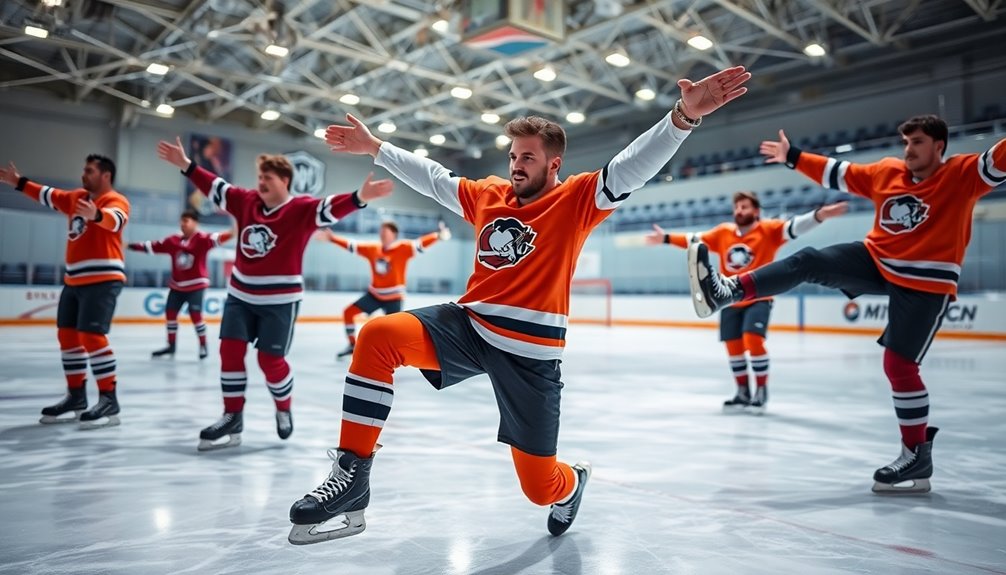
The Ultimate Hockey Stretches to Improve Flexibility
December 20, 2024To improve your flexibility for hockey, incorporate both dynamic and static stretching into your routine. Start with dynamic movements like lunges and high knees to warm up, preparing your muscles for action. After games or practice, focus on static stretches, holding each for 30 seconds to target hamstrings and hip flexors. Don't forget about mobility exercises like the Couch Stretch to alleviate tightness. Consistency is essential; stretch regularly to prevent injuries and enhance performance. By committing to these techniques, you'll set yourself up for success on the ice. Keep going to uncover more effective strategies tailored for you.
Importance of Stretching for Hockey Players
Recognizing the importance of stretching can transform your performance on the ice as a hockey player. Stretching enhances flexibility, which is essential for optimizing your skating mechanics. By incorporating a regular stretching routine, you can alleviate chronic tightness, boost mobility, and ultimately improve your gameplay. Enhanced flexibility can also lead to improved speed and agility, which are crucial attributes for effective skating and maneuverability on the ice.
Increased flexibility through dynamic stretching isn't just about feeling good; it's linked to improved strength and speed, crucial factors for your success in hockey. Tightness and discomfort from skating and stick handling can hinder your performance, but targeted stretches for your hips, lower back, and shoulders can address those issues. Additionally, incorporating a dynamic warm-up routine can effectively prepare your body for the physical demands of the game, enhancing injury prevention and performance.
Establishing a consistent stretching routine is important for injury prevention and recovery. Just a few minutes of daily stretching can lead to significant long-term improvements in flexibility. This not only helps you skate more smoothly but also minimizes the risk of chronic pain. Additionally, enhanced flexibility can significantly improve aerobic endurance during high-intensity bursts on the ice.
Types of Stretching Techniques
When aiming to enhance your flexibility and performance on the ice, understanding the different types of stretching techniques can make all the difference.
Dynamic stretching is essential for warming up your muscles through active movements, promoting blood flow before practices or games. This technique can greatly reduce your injury risk and improve overall performance, similar to how consistency in training enhances skill development in athletes.
Static stretching, on the other hand, is best performed post-activity. By holding stretches for 30 seconds to 2 minutes, you'll help lengthen your muscles and relieve tension, which is beneficial for recovery and increasing flexibility.
Plyometric stretching involves explosive movements like squat tuck jumps, aimed at boosting agility and power, making it an excellent addition to your training routine.
Proprioceptive Neuromuscular Facilitation (PNF) combines contraction and relaxation of muscles during stretching, effectively improving flexibility and range of motion beyond traditional static methods.
Lastly, differentiate between active and passive stretching; active stretching engages your muscles to hold a stretch, while passive stretching relies on an external force.
Incorporating these various stretching techniques into your routine will enhance your mobility and overall performance on the ice. Additionally, incorporating core strength exercises into your regimen can further improve your stability and power on the ice.
Dynamic Stretching Benefits
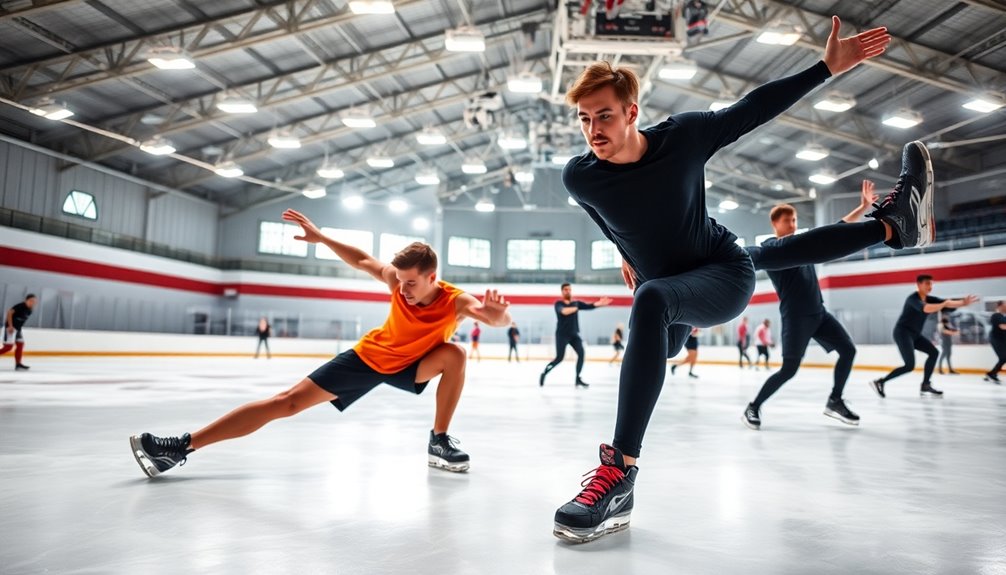
Dynamic stretching offers numerous benefits that can greatly enhance your performance on the ice. By incorporating dynamic warm-ups, you notably increase your core temperature and blood flow to your muscles, which not only boosts performance but also aids in injury prevention. Additionally, these warm-ups are essential for speed and agility drills, which enhance your on-ice movements.
Unlike static stretching, dynamic stretching includes sport-specific movements that better prepare your body for the demands of hockey. Research shows that dynamic stretching has no negative effects on performance when performed before exercise, making it an essential part of your warm-up routine. Engaging in regular practice and drills ensures that your body becomes accustomed to these movements, further enhancing your performance.
Spending 5-15 minutes on dynamic stretches activates your muscles and improves your overall range of motion, allowing for greater flexibility. Dynamic stretches such as lunges and high knees improve your coordination and agility, essential skills for maneuvering the ice effectively.
These movements enhance your mobility, ensuring you can respond quickly during gameplay. By integrating dynamic stretching into your training, you're setting yourself up for success, helping reduce the risk of injury while optimizing your performance. Additionally, incorporating cardio training can further enhance your endurance and overall athletic performance on the ice.
Embrace these benefits, and watch how dynamic stretching transforms your game!
Effective Static Stretching Routine
After a game, it's essential to focus on post-game recovery stretches that target tight muscles. You'll want to use tailored stretching techniques for areas like your hamstrings and hip flexors to enhance flexibility. Incorporating targeted stretching techniques can improve muscle elasticity and readiness for practice. Additionally, performing exercises like Pain Shuttles Drill can further support recovery by enhancing cardiovascular endurance and overall fitness. Regular post-game recovery routines can significantly reduce injury risk and improve overall performance.
Post-Game Recovery Stretches
How can you guarantee your body recovers effectively after a tough hockey game? Incorporating post-game recovery stretches is key. Focus on static stretching techniques, holding each stretch for 30 seconds to 2 minutes. This approach helps restore muscle length and promotes recovery after intense gameplay.
Targeting areas like your hip flexors, hamstrings, quadriceps, and lower back can alleviate chronic tightness, which is often exacerbated during games. Research shows that post-game static stretching can reduce muscle soreness and stiffness, enhancing your overall recovery and preparing you for your next session on the ice.
Make it a habit to include deep stretches for specific muscle groups used in hockey. By doing so, you'll not only improve your flexibility over time but also optimize your skating mechanics. This proactive approach can markedly reduce your injury risk and enhance recovery efficiency.
To maximize the benefits, confirm you focus on your breathing and relax into each stretch. This mindfulness will further aid in muscle recovery, making you feel more prepared for your next challenge.
Embrace these post-game recovery stretches, and watch your performance improve!
Tailored Stretching Techniques
Following your post-game recovery routine, it's important to implement a tailored static stretching routine that targets the specific muscle groups you rely on during hockey.
An effective routine should include static stretches held for 30 seconds to 2 minutes, focusing on major areas like your hamstrings, quadriceps, and hip flexors to enhance flexibility post-activity.
Incorporate stretches like the Couch Stretch and 90/90 Stretch to specifically target tight hip flexors, promoting ideal hip mobility essential for skating performance. Additionally, performing a hamstring stretch and groin stretch not only improves muscle elasticity but also aids in recovery by alleviating soreness after intense games or practices.
Make sure to integrate these static stretches into your cool-down phase after hockey activities. This helps prevent stiffness and promotes blood flow to fatigued muscles.
Monitoring and adapting your static stretching routine based on your individual mobility needs can lead to significant long-term improvements in flexibility and overall athletic performance on the ice.
Creating a Personalized Warm-Up
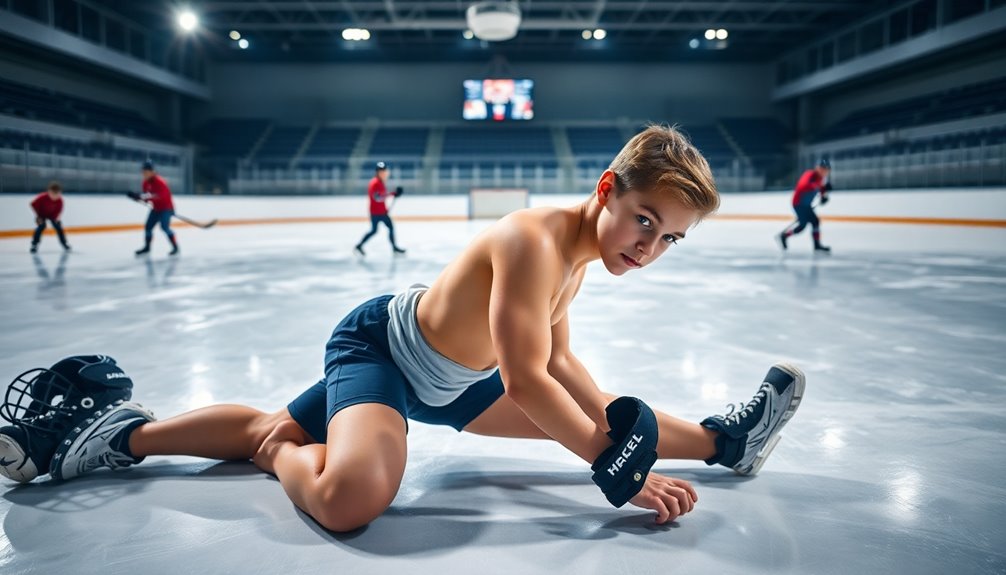
Here's how to create your personalized warm-up routine:
- Dynamic Stretches: Incorporate sport-specific movements like lunges and high knees that mimic the actions you'll perform during games. Engaging in dynamic warm-up routines can further prepare your body for the physical demands of hockey.
- Mobility Exercises: Gradually increase the intensity with exercises that enhance joint flexibility, such as leg swings and torso twists.
- Mental Preparation: Use visualization and breathing techniques to sharpen your focus before you hit the ice. Additionally, maintaining physical and mental freshness is crucial for sustaining your energy levels throughout the game.
Spend 5-15 minutes on your warm-up routine to guarantee your body is ready for the demands of hockey.
Regularly assess and adjust your exercises based on your flexibility progress and any mobility challenges that arise.
By fine-tuning your physical preparation, you'll improve your performance in training sessions and competitions.
Targeted Stretches for Mobility Issues
As a hockey player, you might face common mobility challenges like tight hip flexors or hamstrings that can hinder your performance. By incorporating effective targeted stretches into your routine, you can address these issues and enhance your overall flexibility. Creating a personalized stretching program tailored to your specific needs will help you stay agile on the ice. Additionally, understanding the importance of specific muscle groups can guide you in selecting the most beneficial stretches. Implementing consistent practice of these stretches will further promote flexibility and overall athletic performance.
Common Mobility Challenges
Hockey players often run into mobility challenges that can hold them back on the ice.
These mobility issues, like hip tightness, ankle mobility, and shoulder tightness, can greatly impact your performance and increase injury risk. To enhance your flexibility and movement patterns, it's vital to address these common challenges.
Here are three key mobility challenges to examine:
- Hip Tightness: This can restrict your skating mechanics. Targeted stretches such as the Couch Stretch and the 90/90 Stretch can help alleviate this issue.
- Ankle Mobility: Often overlooked, limited ankle mobility can affect your skating performance. Incorporating exercises like Toes Elevated Ankle Gliders can improve this essential aspect.
- Shoulder Tightness: This can hinder your puck handling and shot accuracy. Stretches like the Banded Lat Stretch are fundamental for promoting upper body mobility and stability.
Effective Targeted Stretches
Flexibility is essential for ideal performance on the ice, and targeted stretches can greatly improve your mobility. Incorporating effective targeted stretches into your routine is imperative for addressing specific areas of tightness that can hinder your performance.
For instance, the Couch Stretch focuses on loosening tight hip flexors and quads, restoring hip function essential for skating. The 90/90 Stretch enhances hip rotation, promoting both internal and external mobility required for executing various skating maneuvers.
Don't overlook the Active/Passive Hamstring Stretches, which alleviate tightness that could lead to knee and low back pain. This can considerably improve your movement on the ice.
To enhance ankle mobility, try the Toes Elevated Ankle Gliders. This stretch is critical for optimizing skating mechanics and preventing injuries linked to lower body tightness.
Lastly, incorporating Groin/Adductor Rocks can effectively release adductor tension, allowing for better lateral movement and reducing the risk of common hockey injuries.
Personalized Stretching Programs
Your personalized stretching program should target your specific mobility issues to maximize performance on the ice.
Begin by conducting mobility assessments to identify areas of tightness or restriction. This tailored approach guarantees you address your unique needs, enhancing your flexibility and skating efficiency.
Here are three key components to include in your customized stretching plans:
- Targeted Stretches: Incorporate effective stretches like the Couch Stretch for hip flexors and the 90/90 Stretch for hip rotation, which considerably improve range of motion.
- Individualized Stretching Techniques: Use techniques that resonate with your body. Consistent practice of these methods leads to long-term improvements, helping you maintain flexibility throughout the hockey season.
- Regular Assessments: Adapt your program regularly based on your progress and evolving mobility needs. This ongoing adjustment helps guarantee ideal outcomes and reduces the risk of injury.
Flexibility Training for Skating Performance
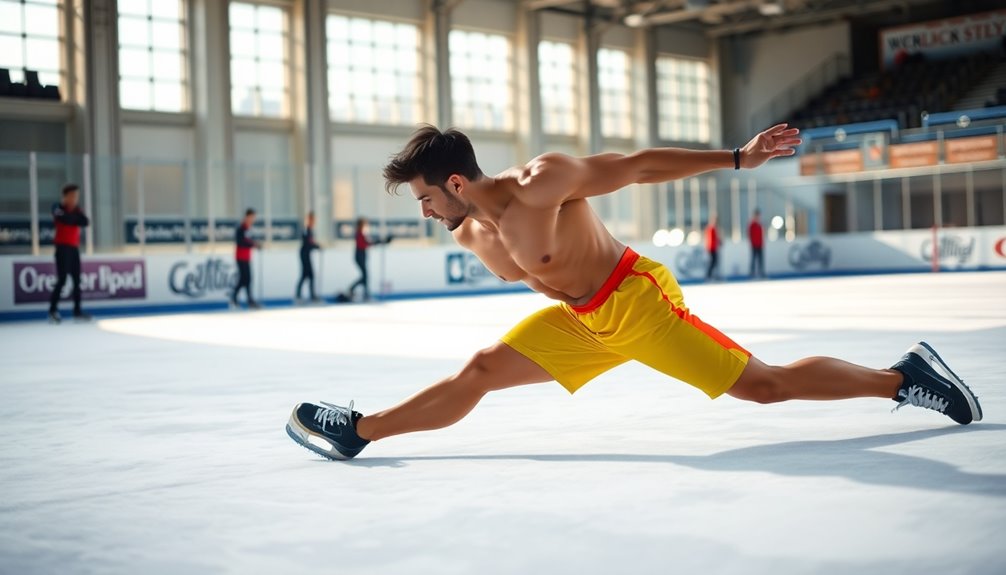
Improving your skating performance on the ice hinges on the often-overlooked aspect of flexibility training. By focusing on hip flexibility, you can enhance your stride length and agility, which are essential for executing powerful skating strides.
Incorporating targeted stretching routines, like the Couch Stretch and 90/90 Stretch, will greatly boost your joint mobility. This enhanced mobility not only helps you maneuver more effectively but also allows for smoother skating patterns.
Research indicates that players with greater flexibility enjoy a noticeable increase in scoring opportunities. Just look at elite players like Connor McDavid and Sidney Crosby; their exceptional skating mechanics demonstrate how flexibility translates to on-ice success.
As you commit to regular flexibility training, you'll notice improved performance in your games, making it easier to navigate the rink and evade opponents.
Common Stretching Mistakes to Avoid
Stretching plays an essential role in enhancing your performance on the ice, but many players make common mistakes that can hinder their progress and lead to injuries. To avoid setbacks, keep these pitfalls in mind:
- Neglecting Warm-Up: Stretching cold muscles increases injury risk. Always engage in light activity for about 10 minutes to prepare your body for stretching.
- Bouncing During Stretches: Avoid bouncing; it can lead to muscle strain. Instead, focus on holding your static stretches in a controlled manner for at least 30 seconds.
- Ignoring Proper Alignment: Failing to maintain proper alignment can result in ineffective outcomes and potential injuries. Prioritize form over depth—this guarantees you're maximizing your flexibility gains.
Overstretching is another mistake to watch out for. Stretch only to the point of resistance, never into pain.
Combine dynamic stretching with static stretches for a thorough approach that prepares your muscles effectively. By steering clear of these common mistakes, you'll set yourself up for better flexibility and performance on the ice.
Long-Term Benefits of Consistent Stretching
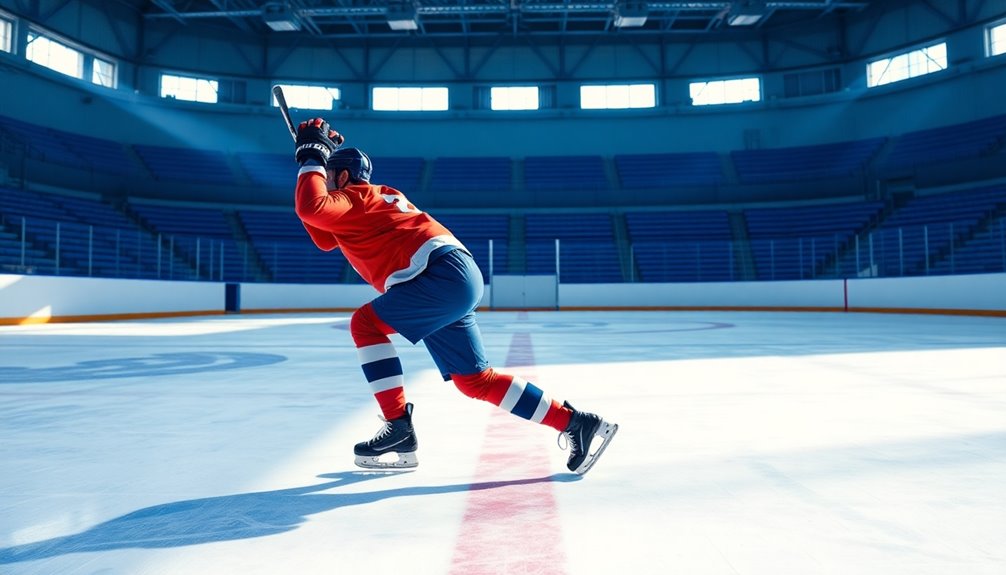
Embracing a consistent stretching routine can greatly enhance your performance on the ice and contribute to your long-term athletic success. When you commit to regular stretching, you'll notice significant improvements in your flexibility, which is essential for refining your skating mechanics. Improved mobility helps you maneuver more effectively, allowing you to outpace your opponents.
Incorporating stretching into your training regimen reduces the risk of injuries commonly faced by hockey players, such as strains and sprains. By maintaining muscle elasticity and joint health, you're setting yourself up for a more resilient body.
Many athletes who stretch consistently report not only reduced tightness and pain but also smoother skating strides that translate into increased power and speed during games.
Establishing a dedicated stretching routine just twice a week can yield noticeable mobility benefits, while daily commitment can lead to even greater long-term benefits.
Ultimately, prioritizing flexibility through consistent stretching not only optimizes your athletic performance but also promotes longevity in your hockey career, minimizing the risk of chronic injuries as you progress.
Embrace the power of stretching to elevate your game and guarantee a thriving future on the ice.
Conclusion
Incorporating these stretches into your routine isn't just about flexibility; it's about elevating your game. Imagine gliding effortlessly across the ice, every movement fluid and precise. By committing to a consistent stretching regimen, you're not just preventing injuries—you're revealing your full potential as a player. So, are you ready to stretch your limits and take your hockey performance to new heights? Start today, and watch how flexibility transforms your game!


